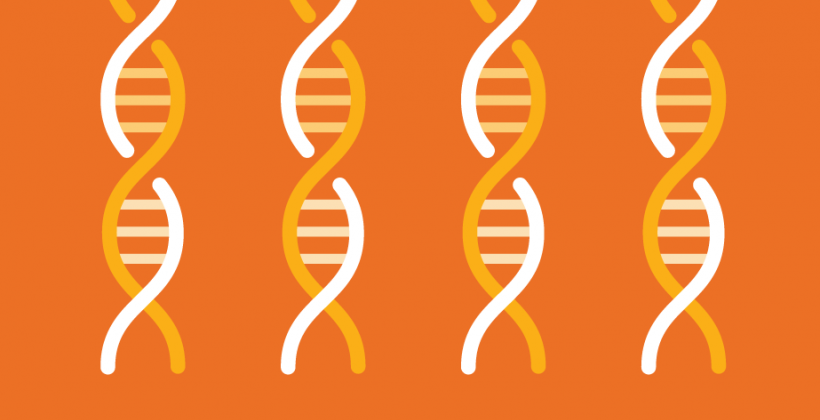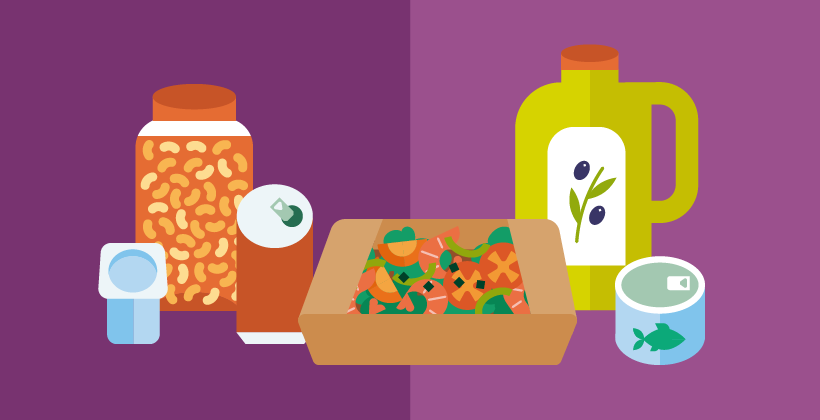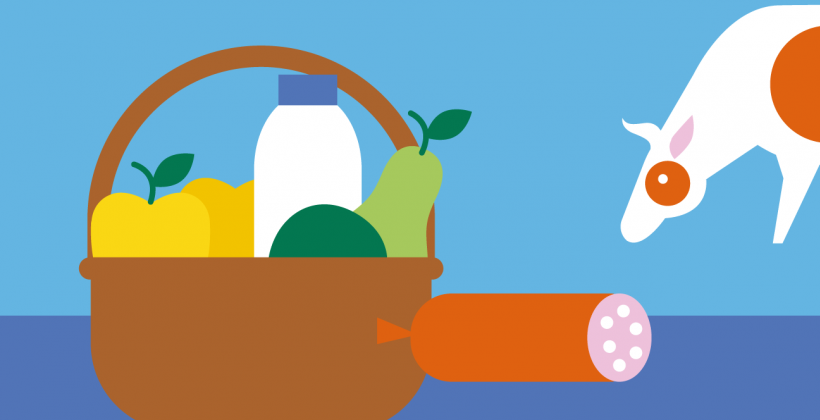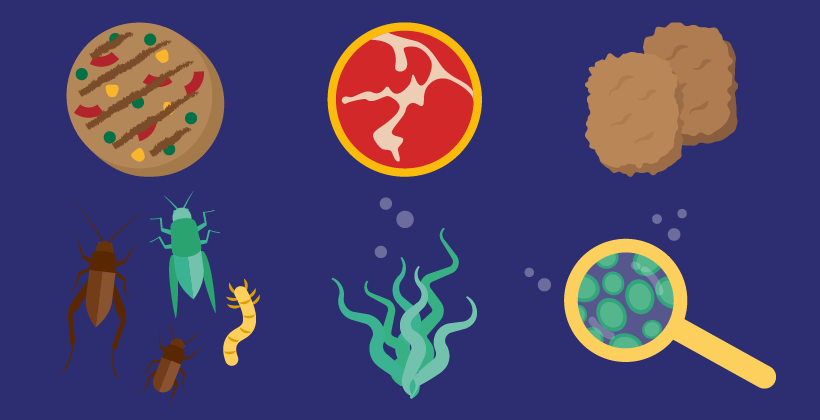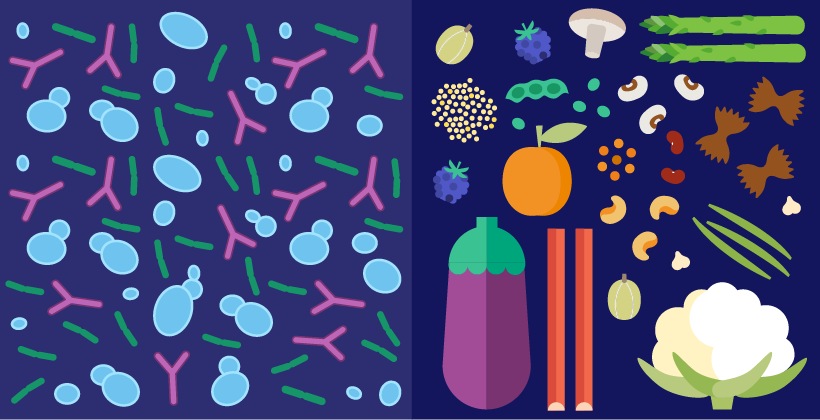Nanotechnology and food (Q&A)
Last Updated : 12 May 20161. What does “nano” mean? How small is nano?
The prefix “nano” is used to describe a specific size range (like “milli-“ or “centi-“). One nanometre is a unit of measure of length that is equal to one-billionth of a metre, or one-millionth of a millimetre. The scale below shows the relative sizes of some familiar objects to give you some idea of just how small a nanometre is:

A nanoparticle is usually considered to be a single particle of matter that is between 1 and 100 nanometres in size. Nanoparticles are too small to be seen with the naked eye or conventional microscopes. Special instruments called atomic force microscopes or electron microscopes must be used to see nanoparticles.
Many people use the word nanomaterial as a general term to describe any matter that is made up of nanoparticles or has a nanoscale structure.
2. What are some examples of nanomaterials that can be found in nature?
Nanomaterials can be found in many places in nature. Some examples include volcanic ash, DNA molecules, and nano-sized hairs on gecko feet which allows them to stick to walls.
3. What is nanotechnology?
Nanotechnology is technology that is performed at the nanoscale and the term encompasses a broad scientific field. It can refer to the creation of new nanomaterials with specific properties or the use of nanomaterials in technology (for example using filters with nano-sized holes to remove unwanted particles from water). It can also refer to the use of an existing technology (for example homogenization or grinding) to produce nanoparticles.
While many naturally-occurring nanomaterials exist, nanomaterials with specific sizes, shapes or compositions can also be manufactured in order to obtain a material that behaves in a desirable way. These are often called “engineered nanomaterials”.
4. Why use nanotechnology?
Because of their small size and large surface area, nanoparticles often behave differently from bigger particles of the same material. To picture how particle size can affect a material’s behaviour, think of the difference between a rock, which is heavy and doesn’t move, and sand, which can flow freely through your fingers. Although they are made of the same thing, their physical behaviour is very different because of their size. By controlling the size or shape of nanoparticles we can create materials that have interesting properties and behave in ways that would otherwise be difficult or impossible to develop.
This is why silver nanoparticles have such good antibacterial properties. They eliminate bacteria by attaching to the surface of their cells and releasing silver ions into them. A million nanoparticles have a much larger combined surface area than one large piece of silver. So together the nanoparticles can attach to and kill many more bacteria (i.e. it is a more efficient antibacterial). Deliberately making nanoparticles in this small size range could therefore be useful in future for example in making antibacterial coatings for food preparation surfaces in kitchens.
Another example is nano-sized titanium dioxide (or TiO2) which is used in sunscreens as it absorbs the UV light from sunlight. Larger particles of titanium dioxide are white and are often used as a white pigment (for example in foods or cosmetics). However, the size of nanoparticles of titanium dioxide means they are not visible to the human eye and therefore they appear transparent. This is why TiO2 nanoparticles can be used to produce transparent sunscreens.
5. Are there nanomaterials in food?
Yes, naturally occurring nanomaterials can also be found in foods. Some examples include proteins in milk or carbohydrate particles in beer. Traditional processing techniques that aim to produce small particles or droplets into a food such as milling (e.g. to produce flour) or emulsifying (e.g. in mayonnaise) can also introduce nano-sized particles into food. These traditional processes have been used in food production for many decades or even centuries.
In fact, our bodies also break down food into nano-sized particles themselves during the digestive process to increase our ability to take up nutrients from the food.
6. If engineered nanomaterials were to be used in food or food production in Europe, how would their safety be ensured?
A regulatory framework is in place in the EU to ensure a high level of health, safety and environmental protection when it comes to food. The General Food Law requires that only safe food is placed on the market. This and other legislation (e.g. specific regulations on food additives, novel foods and food contact materials) ensures the safety of food containing nanomaterials whether naturally-occurring or man-made.
As of today we are not aware of any foods containing engineered nanomaterials on the market in Europe. Any engineered nanomaterials that are currently being developed for food applications would require a safety assessment and approval by European regulators before being placed on the market. Manufacturers also have an obligation to label any food products containing engineered nanomaterials so that this information is clearly available to consumers buying the product.
7. What are the possible benefits/applications of using nanotechnology to produce food?
- Nanotechnology has the potential to introduce a wide variety of benefits when used in food products. Some potential applications and benefits include:
- Hygiene and food safety: antibacterial coatings or nano-sensors that change colour if the food is contaminated.
- Traceability and authenticity in the food supply chain: nano-barcodes for identification and tracking food products. This kind of technology could help to prevent fraud in the food chain, such as the horse meat scandal.
- Food processing: improving texture and flavour; reducing the amount of salt or fat.
- Improving nutrition: nutrients, vitamins or enzymes contained inside a nanoparticle could make it easier for the body to absorb the nutrient while masking any undesirable flavours of these nutrients.
8. What are the potential risks of using nanomaterials in food products?
As with any technology or product, potential risks include impacts on long-term health and the environment. However, we should remember that just because a material is ‘nano’, it does not mean that it is inherently riskier than other materials or chemicals. Safety of any potential use of engineered nanomaterials or nanotechnology in food would need to be proved and assessed by European regulators before it could be used in the EU.
There is general recognition there are still gaps in our knowledge of nanotechnologies and engineered nanomaterials. Considerable research is underway to assess their safety at all stages, from manufacture and exposure in the work place, to their eventual fate in the environment. All these issues are currently under scrutiny at national, EU and international levels.
References
- Chaudhry, Q., Castle, L., & Watkins, R. (Eds.). (2010). Nanotechnologies in food. Royal Society of Chemistry Publishers, ISBN 978-0-85404-169-5.
- Chaudhry Q & Castle L (2011) Food applications of nanotechnologies: an overview of opportunities and challenges for developing countries. Trends in Food Science and Technology 22:595-603
- European Commission. Nanotechnology.
- European Food Safety Authority. Nanotechnology.
- Food Standards Agency, UK. Nanotechnology.
- Sondi, I., and B. Salopek-Sondi. 2004. Silver nanoparticles as antimicrobial agent: a case study on E. coli as a model for Gram-negative bacteria. J. Colloid Interface Sci. 275:177-182.
- Sozer N & Kokini JL (2009) Nanotechnology and it’s applications in the food sector. Trends in biotechnology 27(2):82-89.
- Regulation (EC) No 178/2002 of the European Parliament and of the Council of 28 January 2002 laying down the general principles and requirements of food law, establishing the European Food Safety Authority and laying down procedures in matters of food safe
- Regulation (EC) No 258/97 of the European Parliament and of the Council of 27 January 1997 concerning novel foods and novel food ingredients.
- Regulation (EC) No 1333/2008 of the European Parliament and of the Council of 16 December 2008 on food additives
